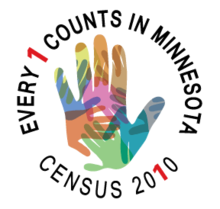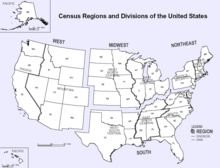संयुक्त राज्य अमेरिका की जनगणना
| संयुक्त राज्य अमेरिका की जनगणना | |
|---|---|
| जालस्थल | census |
कानूनी आधार
प्रक्रिया



अनुप्रयोग
विवाद
इतिहास
| Year | Total population | Progress | Most populated state | Most populated city | Ethnic demographics counted[1] | Slaves | Notes |
|---|---|---|---|---|---|---|---|
| 1790[a] | 3,929,326[b] | — | (747,610) | (33,131) | Free white females and males, other free persons, slaves | 694,280 | Original numbers were corrected later. |
| 1800[c] | 5,308,483[d] | (676,682) | (60,515) | Free white females and males, other free persons, slaves | 893,605[f] | Original numbers were corrected later. | |
| 1810[g] | 7,239,881 | (959,049) | (96,373) | Free white females and males, other free persons, slaves | 1,191,362 | The authorizing act of the third census stipulated that each marshal (enumerator) must personally visit each household, rather than rely on hearsay. | |
| 1820[h] | 9,638,453 | (1,372,812) | (123,706) | Free white females and males, other free persons, free people of color, slaves | 1,538,022 | — | |
| 1830[i] | 12,866,020 | (1,918,608) | (202,589) | Free white females and males, other free persons, free people of color, slaves | 2,009,043 | — | |
| 1840[j] | 17,069,453 | (2,428,921) | (312,710) | Free white females and males, other free persons, free people of color, slaves | 2,487,355 | The census estimated the population of the United States at 17,100,000. The results were tabulated by 28 clerks in the Bureau of the Census. | |
| 1850[k] | 23,191,876 | (3,097,394) | (515,547) | Black, Mulatto, White | 3,204,313 | The 1850 census was a landmark year in American census-taking. It was the first year in which the census bureau attempted to record every member of every household, including women, children and slaves. Accordingly, the first slave schedules were produced in 1850. Prior to 1850, census records had only recorded the name of the head of the household and tabulated the other household members within given age groups. | |
| 1860[l] | 31,443,321 | (3,880,735) | (813,669) | "Indian," Chinese, Black, Mulatto, White | 3,953,761 | The results were tabulated by 184 clerks in the Bureau of the Census. This was the first census where American indigenous people officially were counted, but only those who had 'renounced tribal rules'. The figure for the nation was 40,000. | |
| 1870[m] | 39,818,449[n] | (4,382,759) | (942,292) | "Indian," Chinese, Black, Mulatto, White | — | The first census to provide detailed information on the black population, only years after the culmination of the Civil War when slaves were granted freedom. The results are controversial, as many believed it underestimated the true population numbers, especially in New York and Pennsylvania. | |
| 1880[o] | 50,189,209 | (5,082,871) | (1,206,299) | "Indian," Chinese, Black, Mulatto, White | The first census that permitted women to be enumerators. Also led to the discovery of Alabama paradox. | ||
| 1890[p][n 1] | 62,947,714 | (6,003,174) | (1,515,301) | "Indian," Chinese, Japanese, Black, Mulatto, Quadroon, Octaroon, White | Because it was believed that the frontier region of the United States no longer existed, the tracking of westward migration was not tabulated in the 1890 census.[2] This trend prompted Frederick Jackson Turner to develop his milestone Frontier Thesis. The 1890 census was the first to be compiled using the new tabulating machines invented by Herman Hollerith. The net effect of the many changes from the 1880 census (the larger population, the number of data items to be collected, the Census Bureau headcount, the volume of scheduled publications, and the use of Hollerith's electromechanical tabulators) was to reduce the time required to fully process the census from eight years for the 1880 census to six years for the 1890 census.[3] The total population, of 62,947,714, was announced after only six weeks of processing (punched cards were not used for this family, or rough, count).[4][5] The public reaction to this tabulation was disbelief, as it was widely believed that the "right answer" was at least 75,000,000.[6] This census is also notable for the fact it is one of only three for which the original data are no longer available. Almost all the population schedules were destroyed following a fire in 1921. | ||
| 1900[q] | 76,212,168 | (7,268,894) | (3,437,202) | "Indian," Chinese, Japanese, Black (Negro or of Negro descent), White | — | ||
| 1910[r] | 92,228,496 | (9,113,614) | (4,766,883) | "Indian," Chinese, Japanese, Black (Negro), Mulatto, White, other | — | ||
| 1920[s] | 106,021,537 | (10,385,227) | (5,620,048) | "Indian," Chinese, Filipino, Hindu, Japanese, Korean, Black (Negro), Mulatto, White, other | This was the first census that recorded a population exceeding 100 million. | ||
| 1930[t][n 2] | 122,775,046 | (12,588,066) | (6,930,446) | "Indian," Chinese, Filipino, Hindu, Japanese, Korean, Negro, Mexican, White, other | — | ||
| 1940[u] | 132,164,569 | (13,479,142) | (7,454,995) | "Indian," Chinese, Filipino, Hindu, Japanese, Korean, Negro, White, other | The most recent census where individuals' data have now been released to the public (by the 72-year rule). | ||
| 1950[v] | 150,697,361 | (14,830,192) | (7,891,957) | "American Indian," Chinese, Filipino, Japanese, Negro, White, other | Will be available for public inspection on April 1, 2022. | ||
| 1960[w] | 179,323,175 | (16,827,000) | (7,781,984) | Aleut, "American Indian," Eskimo, Chinese, Filipino, Japanese, Negro, Hawaiian, part-Hawaiian, White | Will be available for public inspection on April 1, 2032. | ||
| 1970[x] | 203,302,031 | (19,953,134) | (7,894,862) | "American Indian," Chinese, Filipino, Japanese, Korean, Negro or Black, Hispanic origin, Mexican, Puerto Rican, Cuban, Central or South American, Hawaiian, White, other | The first census that recorded a population exceeding 200 million. Will be available for public inspection on April 1, 2042. | ||
| 1980[y] | 226,545,805 | (23,667,902) | (7,071,639) | Aleut, Eskimo, "American Indian," Asian Indian, Chinese, Filipino, Japanese, Korean, Vietnamese, Black or Negro, Hispanic origin, Mexican, Mexican-American, Chicano, Puerto Rican, Cuban, other Hispanic, Hawaiian, Guamanian, Samoan, White, other | Will be available for public inspection on April 1, 2052. | ||
| 1990[z] | 248,709,873 | (29,760,021) | (7,322,564) | Aleut, Eskimo, "American Indian," Asian or Pacific Islander, Chinese, Filipino, Korean, Vietnamese, Japanese, Asian Indian, other API, Black or Negro, Hispanic origin, Mexican, Mexican-American, Chicano, Puerto Rican, Cuban, other Hispanic, Hawaiian, Guamanian, Samoan, White, other race | Will be available for public inspection on April 1, 2062. | ||
| 2000[aa] | 281,421,906 | (33,871,648) | (8,008,278) | "American Indian," Alaskan native, Asian Indian, Chinese, Filipino, Japanese, Korean, Vietnamese, other Asian, Black, African American, or Negro, Hispanic origin, Mexican, Mexican-American, Chicano, Puerto Rican, Cuban, other Hispanic, Hawaiian, Guamanian or Chamorro, Samoan, other Pacific Islander, White, other race | Will be available for public inspection on April 1, 2072. | ||
| 2010[ab] | 308,745,538 | (37,253,956) | (8,175,133) | "American Indian," Alaskan native, Asian Indian, Chinese, Filipino, Japanese, Korean, Vietnamese, other Asian, Black, African American, or Negro, Hispanic origin, Mexican, Mexican-American, Chicano, Puerto Rican, Cuban, other Hispanic, Hawaiian, Guamanian or Chamorro, Samoan, other Pacific Islander, White, other race | The first short-form-only census since 1940, as the decennial long form has been replaced by the American Community Survey. The first census that recorded a population exceeding 300 million. Will be available for public inspection on April 1, 2082. |

उत्तर गोपनीय

| अमेरिकी जनगणना क्षेत्र | |||
|---|---|---|---|
| क्षेत्र 1: पूर्वोत्तर | क्षेत्र 2: मिडवेस्ट | क्षेत्र 3: दक्षिण | क्षेत्र 4: पश्चिम |
|
|
|
|
यह भी देखें
- नॉर्मन के। ब्राउन, जिन्हें 1960 से 2020 तक हर जनगणना पर एक गणक के रूप में काम करने के लिए "मिस्टर सेंसस" के रूप में जाना जाता है
- जनगणना-निर्दिष्ट स्थान (सीडीपी), एक आबादी वाला समुदाय जिसमें एक अलग नगरपालिका सरकार का अभाव है
- संयुक्त सांख्यिकीय क्षेत्र (CSA), एक ऐसा क्षेत्र जो निकटवर्ती andSA और MSAs को जोड़ता है
- DUALabs
- ऐतिहासिक जनसंख्या द्वारा अमेरिकी राज्यों की सूची, राज्य-स्तरीय अमेरिकी जनगणना के आंकड़े, 1790–2010, तालिका के रूप में
- संयुक्त राज्य अमेरिका की जनगणना में नस्ल और जातीयता
- संयुक्त राज्य अमेरिका में राज्य सेंसरशिप
- संयुक्त राज्य महानगर क्षेत्र (MSA), एक ऐसा क्षेत्र जिसमें प्रमुख शहरों से सटे समुदाय शामिल हैं
- संयुक्त राज्य अमेरिका micropolitan क्षेत्र (μSA), एक शहरी क्षेत्र के आसपास आधारित 10,000 49,999 करने की आबादी के साथ एक प्रमुख शहर या शहर
टिप्पणियाँ
- ↑ August 2, 1790
- ↑ The number originally published in 1790 was 3,893,635.
- ↑ August 4, 1800
- ↑ The numbers originally published in 1800 was 5,172,312.
- ↑ At the time of the 1800 Census, the territory donated to form the District of Columbia was still being administered by the states of Maryland and Virginia. The state of Maryland included the population of the District under its control within its own return. The population of the District of Columbia within Maryland was 8,144 persons, including 5,672 whites, 400 free blacks, and 2,472 enslaved persons.
- ↑ The number originally published in 1800 was 875,626.
- ↑ August 6, 1810
- ↑ August 7, 1820
- ↑ June 1, 1830
- ↑ June 1, 1840
- ↑ June 1, 1850
- ↑ June 1, 1860
- ↑ June 1, 1870
- ↑ The number originally published in 1870 was 38,555,983.
- ↑ June 1, 1880
- ↑ June 2, 1890
- ↑ June 1, 1900
- ↑ April 15, 1910
- ↑ January 1, 1920
- ↑ April 1, 1930
- ↑ April 1, 1940
- ↑ April 1, 1950
- ↑ April 1, 1960
- ↑ April 1, 1970
- ↑ April 1, 1980
- ↑ April 1, 1990
- ↑ April 1, 2000
- ↑ April 1, 2010
सन्दर्भ
- ↑ "Measuring Race and Ethnicity Across The Decades: 1790—2010 - U.S. Census Bureau". www.census.gov. अभिगमन तिथि 2020-06-26.
- ↑ Porter, Robert; Gannett, Henry; Hunt, William (1895). "Progress of the Nation", in "Report on Population of the United States at the Eleventh Census: 1890, Part 1". Bureau of the Census. पपृ॰ xviii–xxxiv.
- ↑ Report of the Commissioner of Labor In Charge of The Eleventh Census to the Secretary of the Interior for the Fiscal Year Ending June 30, 1895. Washington, DC: United States Government Publishing Office. July 29, 1895. hdl:2027/osu.32435067619882. OCLC 867910652. p. 9: "You may confidently look for the rapid reduction of the force of this office after the 1st of October, and the entire cessation of clerical work during the present calendar year. ... The condition of the work of the Census Division and the condition of the final reports show clearly that the work of the Eleventh Census will be completed at least two years earlier than was the work of the Tenth Census." — Carroll D. Wright, Commissioner of Labor in Charge
- ↑ "Population and Area (Historical Censuses)" (PDF). United States Census Bureau.
- ↑ Truesdell, Leon E. (1965) The Development of Punch Card Tabulation in the Bureau of the Census 1890–1940, US GPO, p. 61
- ↑ Austrian, Geoffrey D. (1982) Herman Hollerith – Forgotten Giant of Information Processing, Columbia, pp. 85–86
सन्दर्भ त्रुटि: "n" नामक सन्दर्भ-समूह के लिए <ref> टैग मौजूद हैं, परन्तु समूह के लिए कोई <references group="n"/> टैग नहीं मिला। यह भी संभव है कि कोई समाप्ति </ref> टैग गायब है।